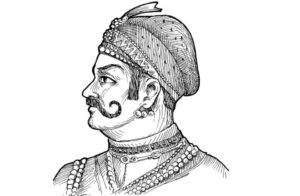The Chauhan Dynasty
The word Chauhan is the vernacular form of the Sanskrit term Chahamana. While the earlier versions of Chandbardai’s work Prthviraj Raso doesnot mention Chauhan as born from Agnikunda, the later versions do.
The 15th-century Hammira Mahakavya of Nayachandra Suri & Jayanayak’s Prithviraj Vijay consider Chauhans as Suryavanshi. Pandit Gaurishankar Ojha seconds this opinion.
Based on Bijloia Inscription (1170 CE), Dr. Dasrath Sharma considers that early ancestor of Chauhan was born at Ahichchhatrapura in the gotra of sage Vatsa. Ahichchhatrapura can be identified with modern Nagaur.
Chahamanas probably started out as petty rulers of Ahichchhatrapura. As the Chahamana territory expanded, the entire region ruled by them came to be known as Sapadalaksha.
In course of time Chauhans formed ruling dynasties at various places. Major Chauhan dynasties include:
- Chauhans of Shakambhari
- Chauhans of Ranthambore
- Chauhans of Jalore
Apart from these, there are other ruling dynasties that claim Chauhan descent including:
- Haras of Hadoti
Chauhans of Shakambhari:
- Vasu-deva (c. 6th century CE)
- Considered as founder of Shakambhari branch of Chauhans around 551 CE
- According to a mythical account in Prithviraja Vijaya, he received the Sambhar Salt Lake as a gift from a vidyadhara (a supernatural being).
- Samanta-raja (c. 684-709 CE); identified as the legendary Manik Rai by R. B. Singh
- Nara-deva (c. 709-721 CE)
- Ajaya-raja I (c. 721-734 CE), alias Jayaraja or Ajayapala
- Vigraha-raja I (c. 734-759 CE)
- Chandra-raja I (c. 759-771 CE)
- Gopendra-raja (c. 771-784 CE)
- Durlabha-raja I (c. 784-809 CE)
- Govinda-raja I (c. 809-836 CE), alias Guvaka I
- Constructed Harshnath Temple in Sikar
- Chandra-raja II (c. 836-863 CE)
- Govindaraja II (c. 863-890 CE), alias Guvaka II
- Chandana-raja (c. 890-917 CE)
- Vakpati-raja (c. 917-944 CE)
- Simha-raja (c. 944-971 CE)
- Vigraha-raja II (c. 971-998 CE)
- Durlabha-raja II (c. 998-1012 CE)
- Govinda-raja III (c. 1012-1026 CE)
- Vakpati-raja II (c. 1026-1040 CE)
- Viryarama (c. 1040 CE)
- Chamunda-raja (c. 1040-1065 CE)
- Durlabha-raja III (c. 1065-1070 CE), alias Duśala
- Vigraha-raja III (c. 1070-1090 CE), alias Visala
- Prithvi-raja I (c. 1090-1110 CE)
- Ajaya-raja II (c. 1110-1135 CE),
- Moved the capital to Ajayameru (Ajmer)
- Repulsed a Ghaznavid attack, and also defeated the Paramara king Naravarman.
- Arno-raja (c. 1135-1150 CE), alias Ana
- Defeated Turkish invaders
- Constructed Anasagar Lake at Ajmer
- Jagad-deva (c. 1150 CE)
- Vigraha-raja IV (c. 1150-1164 CE), alias Visaladeva
- Expanded the Chauhan territories, and captured Delhi from the Tomaras.
- Apara-gangeya (c. 1164-1165 CE)
- Prithvi-raja II (c. 1165-1169 CE)
- Someshvara (c. 1169-1178 CE)
- Prithvi-raja III (c. 1178-1192 CE)

Prithviraj Chauhan III - Better known as Prithviraj Chauhan
- Defeated Mohd. Ghori in first Battle of Tarain in 1191.
- Govinda-raja IV (c. 1192 CE)
- Banished by Hari-raja for accepting Muslim suzerainty;
- Established the Chauhan branch of Ranthambore
- Hari-raja (c. 1193-1194 CE)

